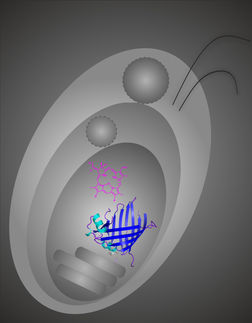Scientists find quantum mechanics at work in photosynthesis
A team of University of Toronto chemists have made a major contribution to the emerging field of quantum biology, observing quantum mechanics at work in photosynthesis in marine algae.
"There's been a lot of excitement and speculation that nature may be using quantum mechanical practices," says chemistry professor Greg Scholes, lead author of a new study published in Nature . "Our latest experiments show that normally functioning biological systems have the capacity to use quantum mechanics in order to optimize a process as essential to their survival as photosynthesis."
Special proteins called light-harvesting complexes are used in photosynthesis to capture sunlight and funnel its energy to nature's solar cells – other proteins known as reaction centres. Scholes and his colleagues isolated light-harvesting complexes from two different species of marine algae and studied their function under natural temperature conditions using a sophisticated laser experiment known as two-dimensional electronic spectroscopy.
"We stimulated the proteins with femtosecond laser pulses to mimic the absorption of sunlight," explains Scholes. "This enabled us to monitor the subsequent processes, including the movement of energy between special molecules bound in the protein, against a stop-clock. We were astonished to find clear evidence of long-lived quantum mechanical states involved in moving the energy. Our result suggests that the energy of absorbed light resides in two places at once – a quantum superposition state, or coherence – and such a state lies at the heart of quantum mechanical theory."
"This and other recent discoveries have captured the attention of researchers for several reasons," says Scholes. "First, it means that quantum mechanical probability laws can prevail over the classical laws of kinetics in this complex biological system, even at normal temperatures. The energy can thereby flow efficiently by—counter intuitively—traversing several alternative paths through the antenna proteins simultaneously. It also raises some other potentially fascinating questions, such as, have these organisms developed quantum-mechanical strategies for light-harvesting to gain an evolutionary advantage? It suggests that algae knew about quantum mechanics nearly two billion years before humans," says Scholes.
Other news from the department science
Most read news
More news from our other portals
See the theme worlds for related content
Topic World Spectroscopy
Investigation with spectroscopy gives us unique insights into the composition and structure of materials. From UV-Vis spectroscopy to infrared and Raman spectroscopy to fluorescence and atomic absorption spectroscopy, spectroscopy offers us a wide range of analytical techniques to precisely characterize substances. Immerse yourself in the fascinating world of spectroscopy!

Topic World Spectroscopy
Investigation with spectroscopy gives us unique insights into the composition and structure of materials. From UV-Vis spectroscopy to infrared and Raman spectroscopy to fluorescence and atomic absorption spectroscopy, spectroscopy offers us a wide range of analytical techniques to precisely characterize substances. Immerse yourself in the fascinating world of spectroscopy!
























































